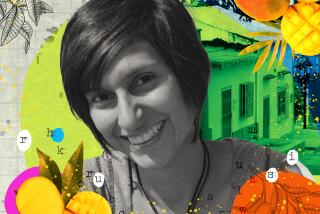CITY TERRACE : Latina Astronaut Clarifies the Mission
- Share via
The nation’s first Latina astronaut, on a visit to the Eastside last week, revealed a culinary secret of last month’s space shuttle mission: Tortillas are better than bread.
“One of our favorite foods is tortillas,” said Ellen Ochoa, who orbited Earth for nine days aboard Discovery, launched April 8. “No. 1: They taste good. And No. 2: They’re flat and pack well. Bread creates crumbs that, when you’re in space, just fly around.”
Ochoa visited Belvedere Junior High School, Cantwell Elementary and the Salesian Boys and Girls Club on Tuesday before meeting with area teachers at Plaza de la Raza at Lincoln Park. As part of her job with the National Aeronautics and Space Administration, Ochoa speaks to children about the importance of education.
She was accompanied by Earl J. Montoya, program manager for the Atmospheric Laboratory for Applications and Science program. Last month’s Discovery mission was the second of 10 missions for that program, which entails gathering data on ozone depletion and completing other atmospheric experiments.
“I manage a series of missions that go on the shuttle, measuring three things, how the atmosphere is being affected by people, nature and the sun,” Montoya told children and teen-agers at the Boys and Girls Club in City Terrace. In Spanish, he told them that he came from a small mining and ranching town, and that they can reach their goals, just as he has at NASA. “ Es posible (It’s possible),” he said.
Dressed in a navy-blue jumpsuit sporting NASA patches, Ochoa showed slides from the mission in which the crew deployed a satellite that studied the sun. Ochoa, a physicist with a doctorate in electrical engineering, operated the robotic arm that later retrieved it.
“It is a very beautiful sight,” she said of viewing Earth. “You can see cities, mountain ranges, lakes. We never got tired of looking at it.”
Children asked how the astronauts breathe in space, (they haul a tank of oxygen on the shuttle), how long it takes to orbit Earth, (1 1/2 hours traveling at 17,000 m.p.h.), and whether the takeoff causes much pollution (minimal because only a small part of the fuel is solid fuel with some potentially damaging chemicals).
“I expected most astronauts to be conceited,” said Ivan Aviles, 11. “It’s the first time I’ve seen an astronaut and I think she has a nice attitude. I wouldn’t mind being an astronaut myself.”
More to Read
Sign up for Essential California
The most important California stories and recommendations in your inbox every morning.
You may occasionally receive promotional content from the Los Angeles Times.













